|
|
|
| My Favourite Planet > English > Middle East > Turkey > Ephesus > photo gallery |
| Ephesus, Turkey |
Ephesus photo gallery 1 |
 |
 |
61 of 62 |
 |
 |
|
| |
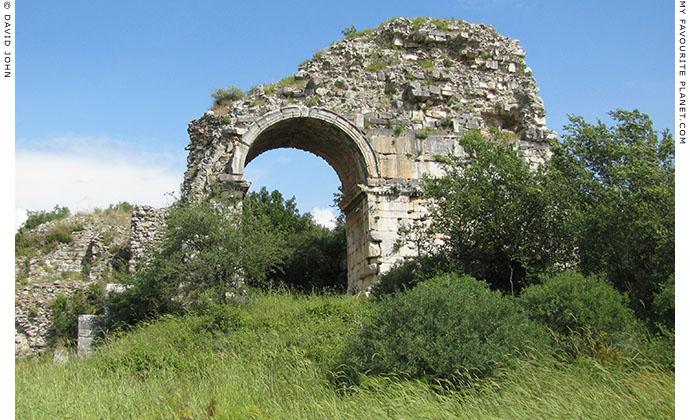
The remains of the monumental entrance to the Ephesus Stadium, north of the archaeological site. |
| |
Ephesus Stadium and Vedius Gymnasium
If you arrive or leave the Ephesus archaeological site by the lower entrance, you will pass this massive ruin on the road to Selcuk. [1] This is just a fragment of what was the soth end of the Stadium's monumental entrance, and practically all that remains of the city's enormous sports arena.
The ruins of the stadium and the gymnasium are not open to the public, but various architectural fragments can be seen through the high, chain-link fence around the site. Even the information board for the stadium is a metre or two beyond the fence, making it almost impossible to read for mere mortals.
A stadium was built here in the Hellenistic Period, just inside the city walls near the Koressos Gate, one of the two main gateways to the city (the other was the Magnesian Gate, outside the upper entrance to Ephesus). During the reign of Emperor Nero (54-58 AD) it was expanded on a grand scale, financed by public subscription. The original seating on the south side, built on the slope at the foot of Mount Pion (Panayır Daği), was extended up the hill, and tiers of seating were also added to the north side, supported by a retaining wall and a vaulted substructure.
The expanded stadium had the traditional elongated U-form, though quite irregular in shape (see the plan below). A walled-off section, around 50 x 40 metres, at the eastern (rounded) end of the Stadium was used as an arena, probably for gladiatorial contests.
It dwarfed even the Great Theatre, with a length of 230 metres and a width 40 metres, it is said to have had a seating capacity of 13,000.
After the official adoption of Christianity in the Roman Empire from the mid 4th century, such stadia fell into disuse. A church was built in the western end during the 5th century, and the stadium was gradually dismantled as its stone was quarried for building material, particularly for the Basilica of Saint John in Selçuk.
The Vedius Gymnasium (see photo below) stood just to the north of the stadium, directly at the city walls. The bath-gymnasium complex measured 135 x 85 metres and covered a total area of around 13,000 square metres. It was financed by M. Claudius P. Vedius Antoninus Phaedrus Sabinianus [2] and his wife Flavia Papiani who dedicated it to Artemis and Emperor Antoninus Pius, and opened 147-149 AD. It was renovated around 400 AD and remained in use until the end of the 5th century. It was destroyed by fire in the 6th century.
The ancient artifacts discovered at the gymnasium include:
Two colossal statues of river gods, found during excavations in 1928. One is now in the Istanbul Archaeological Museum, the other in the Izmir Museum of History and Art (see photos below).
The first "Alkamenes herm of the Ephesus type" discovered (also 1928), now in the Izmir Archaeological Museum (see Pegamon gallery 2, page 15).
An "Ikarios relief" of Dionysus (see the Dionysus page of the People section).
A marble statue of Antinous portrayed as Androklos, the mythological founder of Ephesus. 138-161 AD. Discovered in 1927. Izmir Archaeological Museum. Inv. No. 45 (see gallery page 23).
A marble statue identified as a portrait of a Sophist philosopher, dated to the reign of Septimius Severus (193-211 AD). Now in the Izmir Museum of History and Art (see photo below).
On the opposite side of the road, around the 34 metre high hill directly in front of the stadium, are the remains of a number of ancient buildings (see next page). |
|
| |
| |
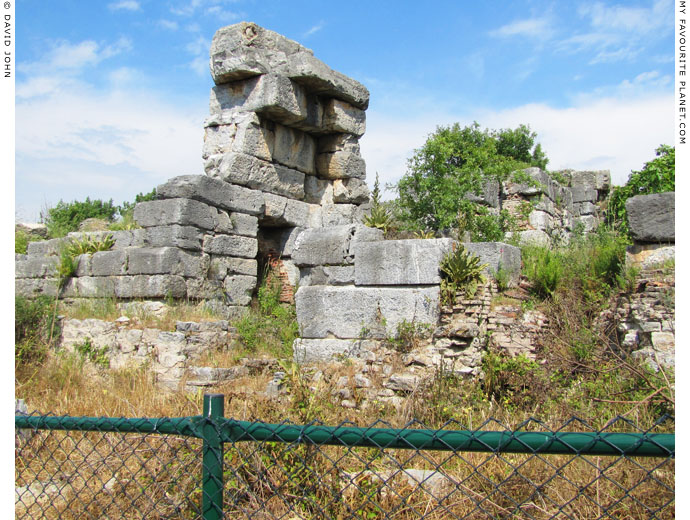
The ruins of part of the Vedius Gymnasium, beyond the 2 metre high fence. |
| |
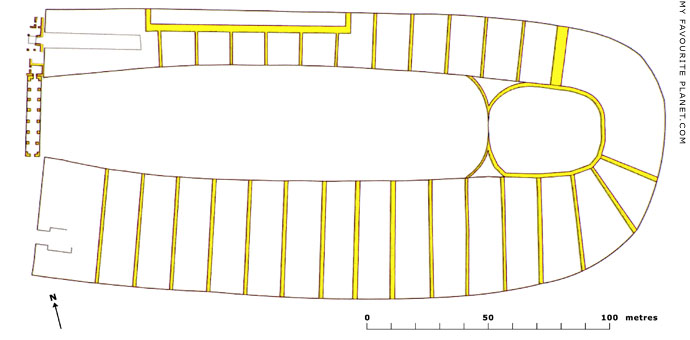
The irregular plan of the Ephesus Stadium.
See a photo of the more regular-looking Panathenaic Stadium in Athens, Greece. |
| |
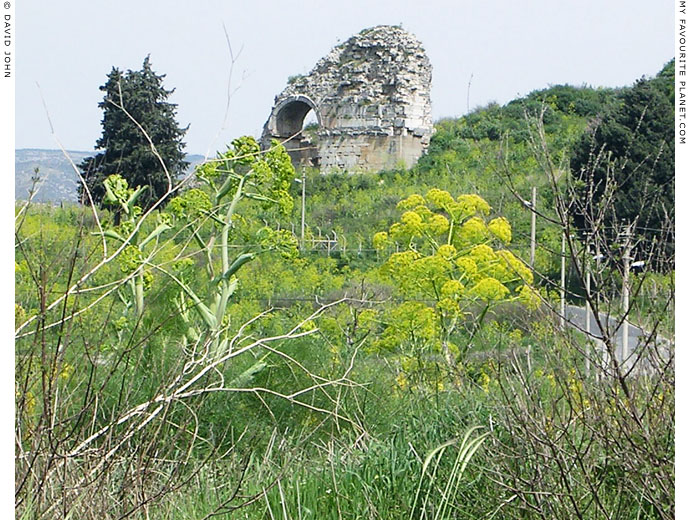
The entrance arch of the Ephesus Stadium viewed from the Tracheia Hill (see next page). |
| |
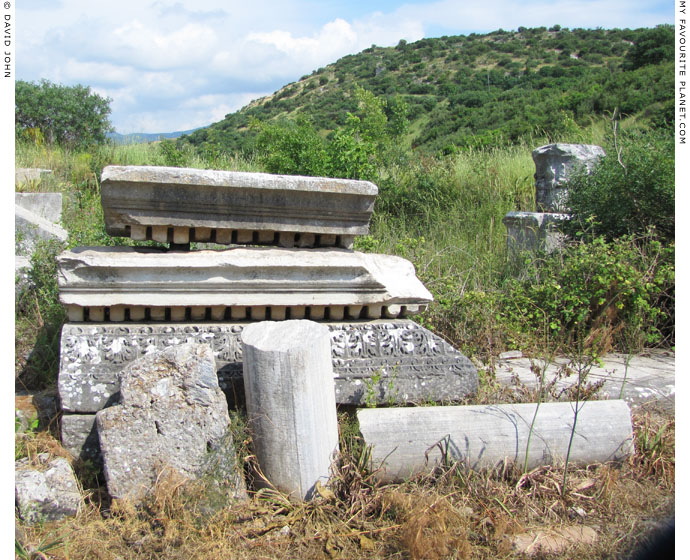
A pile of architectural members outsdie the Ephesus Stadium, as seen through the fence.
In the background, right, is the northwest slope of Mount Pion (όρος Πίων; Turkish, Panayır Daği). |
| |
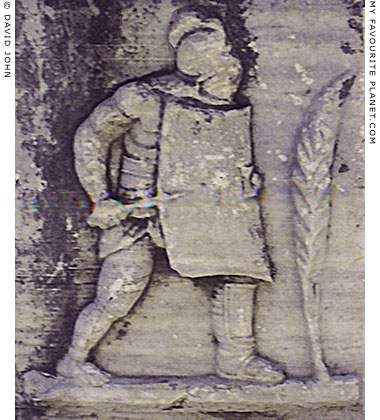
A relief of a gladiator and a palm branch, a symbol of victory, on
the front of a marble funerary stele in Ephesus. 2nd - 3rd century AD.
For years the relief was displayed in the Lower Agora (where this photo was
taken in 1985), then moved to the Marble Street, near the Great Theatre. It has
recently been taken to the safety of the Ephesus Archaeological Museum, Selçuk.
See a photo of another gladiator relief from Ephesus below. |
| |
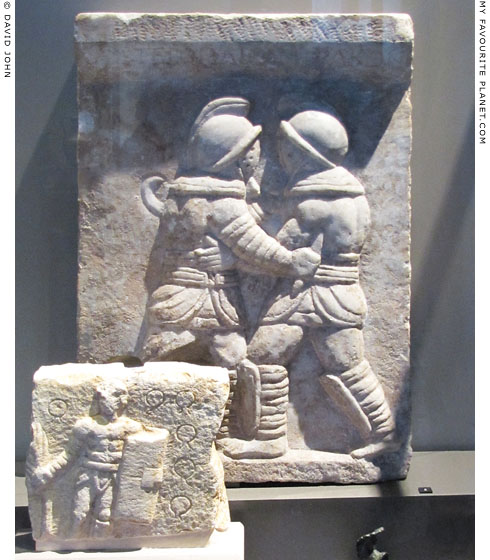
A marble relief of a gladiatorial duel from Ephesus, 3rd century AD. Part of
a parapet. According to the inscription, Asteropios the hoplomachus
(ὁπλομάχος, literally, shield fighter) defeated Drakon the thraex (Thracian).
Neues Museum, Berlin. Inv. No. SK 964.
In the museum display the relief is partly obscured by another, smaller relief
of a provocator. 1st - 4th century AD, provenance unknown. Inv. No. SK 966.
See: Eckart Köhne, Cornelia Ewigleben, Gladiators and Caesars: The Power of
Spectacle in Ancient Rome. University of California Press, 2000. At googlebooks. |
| |
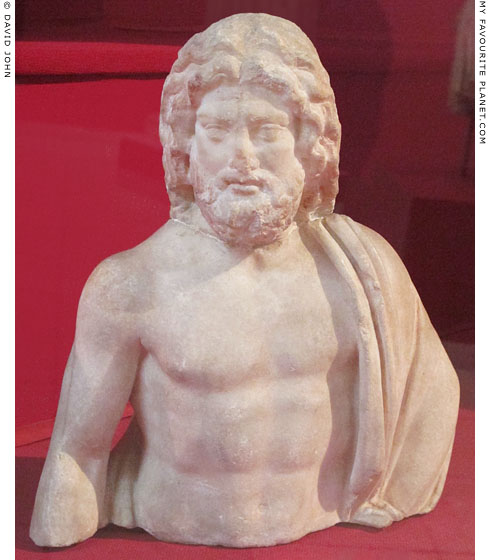
Upper part of a marble statuette of the healing god Asklepios.
Roman period. Found in 1928 in the Vedius Gymnasium, Ephesus.
White crystalline marble. Height 36 cm, width 27 cm, depth 16 cm.
There is thought to have been an Asklepieion, a sanctuary of Asklepios as healing centre,
in Ephesus, although its location has not yet been discovered (see gallery page 62).
However, it is known that doctors, "sons of Asklepios", such as Galen of Pergamon were
employed to treat gladiators (see Pergamon Gallery 1, page 35).
Izmir Museum of History and Art. Inv. No. 640. |
| |
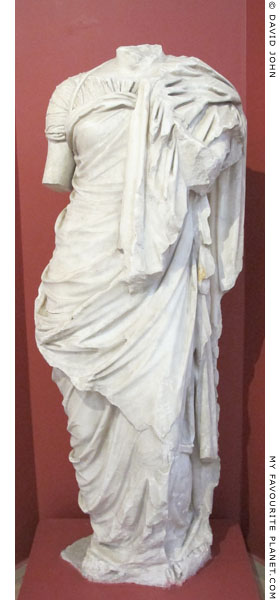
A marble statue, head and arms now
missing, thought to depict the healing
goddess Hygeia, daughter of Asklepios.
Antonine period (138-161 AD). Found in
1926 in the Vedius Gymnasium, Ephesus.
Height 166 cm, width 61 cm, depth 47 cm.
Izmir Museum of History and Art. Inv. No. 39. |
|
|
|
| |
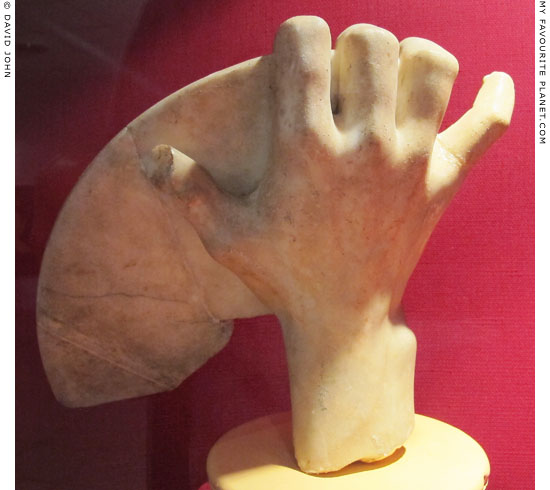
A marble right hand holding a discus.
Found in 1927 in the Vedius Gymnasium, Ephesus.
Height 24 cm, width 26 cm.
Izmir Museum of History and Art. Inv. No. 473.
|
Around lifesize, the hand was presumably part of a statue of a Discobolus (Δισκοβόλος), a naked athlete about to throw a discus, the most famous ancient Greek example of which was made in bronze by Myron of Eleutherai around 460-450 BC, known from a number of extant Roman period marble copies. The hand itself is well preserved, with only the end of the thumb and part of the tip of the little finger missing. Part of the forearm to just below the wrist has survived. It is very lifelike and details include the fingernails, creases in the fingers and tendons of the wrist, although the other side of the sculpture is not visible in the museum display. A little less than a quarter of the discus has survived, with two fragments restored.
See a photo of the other side of the hand in: Serdar Aybek, Izmir Tarih ve Sanat Müzesi, Heykel Kataloğu (Izmir Museum of History and Art, Sculpture catalogue), No. 101, page 107. T.C. Kültür ve Turizm Bakanliği, Kültür Varlıkları ve Müzeler Genel Müdürlüğü, Ankara, 2009. At academia.edu. |
|
|
| |
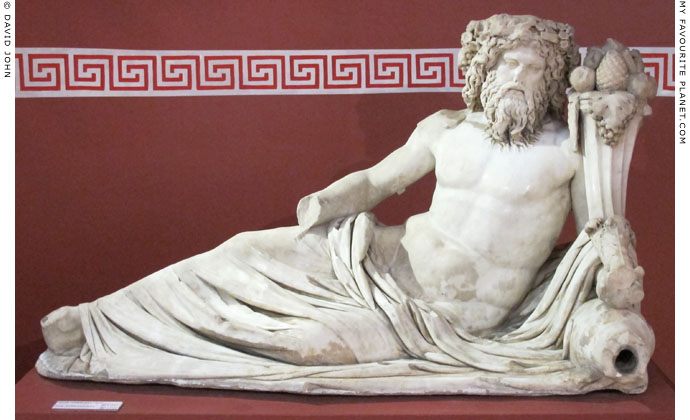
A colossal marble statue of a reclining river god with a cornucopia,
identified as a personification of the local river Kaystros (Κάυστρος).
Found in 1928 in situ, on a base in the natatio (swimming pool) of the
frigidarium at the north end of the Vedius Gymnasium, Ephesus. Roman
period, 2nd century AD. Height 115 cm, width 206 cm, depth 102 cm.
Izmir Museum of History and Art. Inv. No. 78.
|
Both the river god statues found in the Vedius Gymnasium, this one now in Izmir and the other in Istanbul (see photo below), have been dated stylistically to the reign of Emperor Antoninus Pius (138-161 AD), and are thought to be based on a Hellenistic model. They have been tentatively identified as representations of Kaystros, although the Istanbul statue is labelled Okeanos. [3]
Depictions of river gods were popular, especially during the Roman period when many were made for fountains in baths, public spaces and private residences. Several similar extant statues from around the Roman Empire can not be definitely identified as depicting a specific deity because of the lack of inscriptions or distinguishing attributes.
As with the statue in Istanbul, the god has long, uncombed hair and a full beard. His head faces the viewer and is slightly lowered. His expression appears to be pensive. He is naked to just below the abdomen, so that only his genitals and legs are covered by his himation (cloak), one corner of which is draped around his left forearm. His feet are left exposed. The Izmir god also wears a wreath of flowers, leaves and fruit, which along with the cornucopia refer to the fertiltiy of the land and the riches provided by the river which he personifies. His left elbow rests on an amphora through which a pipe has been run. Water poured through the pipe to feed the pool. He reclines on a surface perhaps meant to indicate a watery surface, a shore or river bank. The pose is similar to sculpted figures of deities and mortals lying on klines (couches) on votive reliefs (see some examples) and on the top of sarchophagi (see some examples). Perhaps he is resting from his divine duties and activities, reflecting the comfort and ease enjoyed by those using the baths. |
|
|
| |
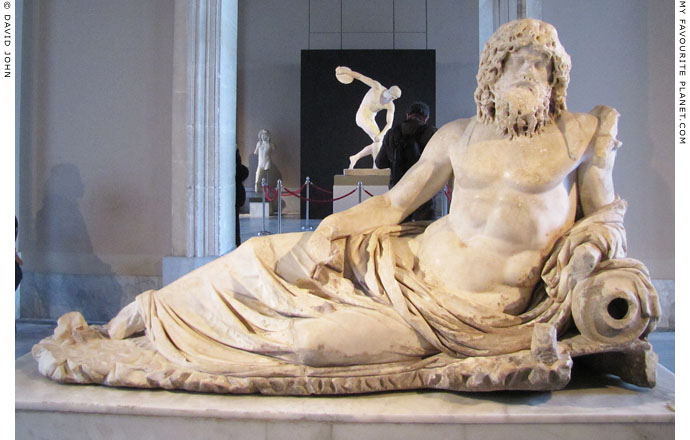
A colossal marble statue of a reclining river god, identified as either
Kaystros or the supreme river god Okeanos (museum labelling).
Found in 1928 in situ, on a base in the natatio (swimming pool)
of the frigidarium in the Vedius Gymnasium, Ephesus.
Roman period, 2nd century AD. Height 128 cm, width 218 cm.
Istanbul Archaeological Museum. Inv. No. 4281 T. |
| |
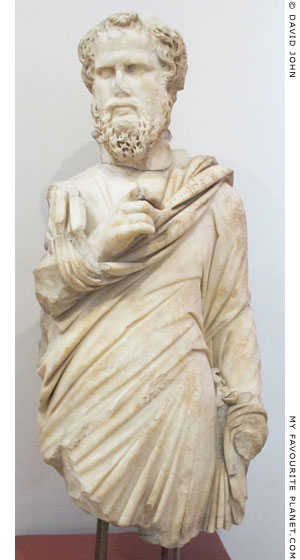 |
|
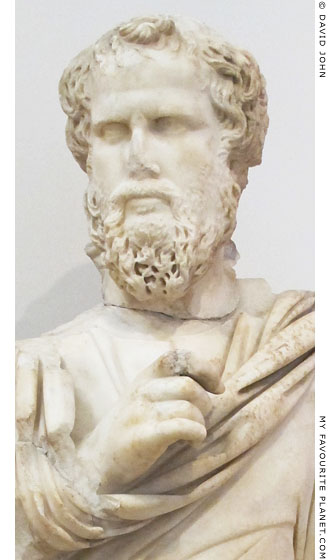 |
A marble statue of a Sophist from Ephesus.
Found in 1927 in the "Emperor's Hall" of the Vedius Gymnasium.
Roman period, 193-211 AD. Height 115 cm, height of head 31 cm.
It has been suggested that this may be a portrait of the Ephesian
Sophist Titus Flavius Damianus. Another statue thought to be
a portrait of Damianus was found in the East Gymnasium.
Izmir Museum of History and Art. Inv. No. 570. |
|
| |
Ephesus
Stadium
and
Vedius
Gymnasium |
Notes, references and links |
 |
|
1. The Stadium entrance arch
The keystone of the arch appears to have a bas-relief of a figure, although it is difficult to see from the road.
2. Publius Vedius Antoninus and the Vedii
The name Publius Vedius Antoninus has proved a problem for researchers into the history of Ephesus, as there thought to have been four men of different generations during the 2nd century with this name. They are usually referred to as being members of the family Vedii (or Vedii Antonini), thought to be immigrants from Italy and descendants of P. Vedius Pollio (a Roman knight and an ally and friend of Augustus). P. Vedius Antoninus is thought to have been the last of the blood line and to have adopted M. Claudius Sabinus who continued the Vedii name.
This is just one of very many complex puzzles involving the relationships between individuals and families across the Roman Empire (see, for example, Herodes Atticus). Several academic articles have been written on the subject and attempts have been made to reconstruct the Vedii family tree. Studies of the inscriptions mentioning the four men have led to the following chronological order, which remains a subject of debate:
1. P. Vedius Antoninus, "the adoptive father"
2. M. Claudius P. Vedius Antoninus Sabinus, "the adoptive son"
3. M. Claudius P. Vedius Antoninus Phaedrus Sabinianus, "the builder"
4. M. Claudius P. Vedius Papianus Antoninus, "the inheritor"
The last of the four died childless and bequeathed much of his large fortune to the Temple of Artemis. His sister Vedia Phaedrina married the sophist Titus Flavius Damianus (Damianus of Ephesus), and the Vedii was name passed on to one of their sons Titus Flavius Vedius Antoninus.
The bibliography on the subject is large, and I shall attempt to include some key citations and more details about the inscriptions when there is time.
See a discussion of the families of the Vedii and Damianus as well as several inscriptions from Ephesus, Rome, Tralleis, Aphrodisias and Pergamon relating to them:
Ursula Quatember, Veronika Scheibelreiter-Gail and Stefan Hagel, T. Flavius Damianus und der Grabbau seiner Familie. In: Jahreshefte des Österreichischen Archäologischen Institutes in Wien (ÖJh), Band 86, 2017, pages 221-354. Verlag Holzhausen, Vienna, 2018. The appendix (Anhang) on pages 305-342 contains 87 inscriptions, with the Greek texts and German translations, as well as a concordance (Konkordanzen, page 342).
A Publius Vedius Antoninus is mentioned as grammateus (γραμματεύς, town clerk) of Ephesus for the second time and the asiarch (Ἀσιάρχης, the high priest of the imperial cult in the province of Asia) on the dedicatory inscription of the "Temple of Hadrian". This has led to a debate over which of them was meant, a question crucial to the dating of the temple's construction (see the note on gallery page 21).
An inscription identifies a Publius Vedius Antoninus as having financed the building of a new skene (stage house) for the Bouleuterion (Odeion) around 150 AD, during the reign of Emperor Antoninus Pius (138-161 AD). A decree quoting a letter from Antoninus Pius to the Ephesians, 140-144 AD, is signed by Publius Vedius Antoninus as grammateus (see note on gallery page 9).
3. River god statues from Ephesus
The University of Köln Arachne website cautiously describes both statues merely as river gods.
Description of the Izmir statue: arachne.uni-koeln.de/item/objekt/8012
Description of the Istanbul statue: arachne.uni-koeln.de/item/objekt/7679
The 1935 guidebook to the Istanbul Archaeological Museum describes the statue there as:
"Statue d'un dieu barbu couché. Trouvé dans les Thermes d'Antoninus Vedius à Ephèse. Cette statue représente problemènt le fleuve Caystrè. IIe s. ap. J. - C."
"Statue of a reclining bearded god. Found in the Thermae of Antoninus Vedius at Ephesus. This statue probably represents the river Cayster. 2nd century AD."
Musées d'Istanbul: Guide illustré des sculptures grecques, romaines et byzantines, I 4281, page 79. Devlet Matbaasi, Istanbul, 1935. |
|
|
Photos, articles and map: © David John,
except where otherwise specified.
Additional photos: © Konstanze Gundudis
All photos and articles are copyright protected.
Images and materials by other authors
have been attributed where applicable.
Please do not use these photos or articles without permission.
If you are interested in using any of the photos for your website,
project or publication, please get in contact.
Higher resolution versions are available on request.
Some of the information and photos in this guide to Ephesus
originally appeared in 2004 on davidjohnberlin.de. |
|
| |
 |
Visit the My Favourite Planet Group on Facebook.
Join the group, write a message or comment,
post photos and videos, start a discussion... |
|
|
| |
|
|
|